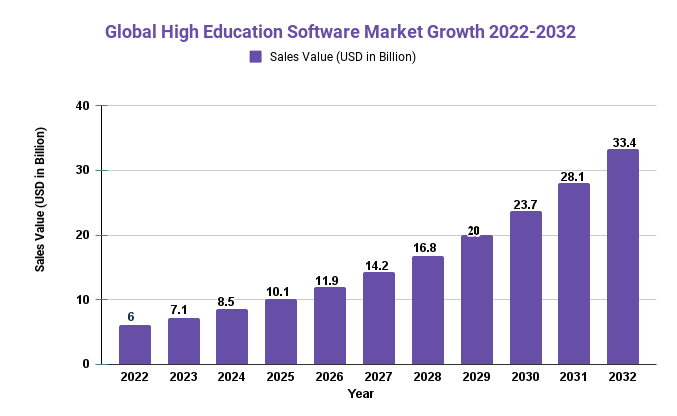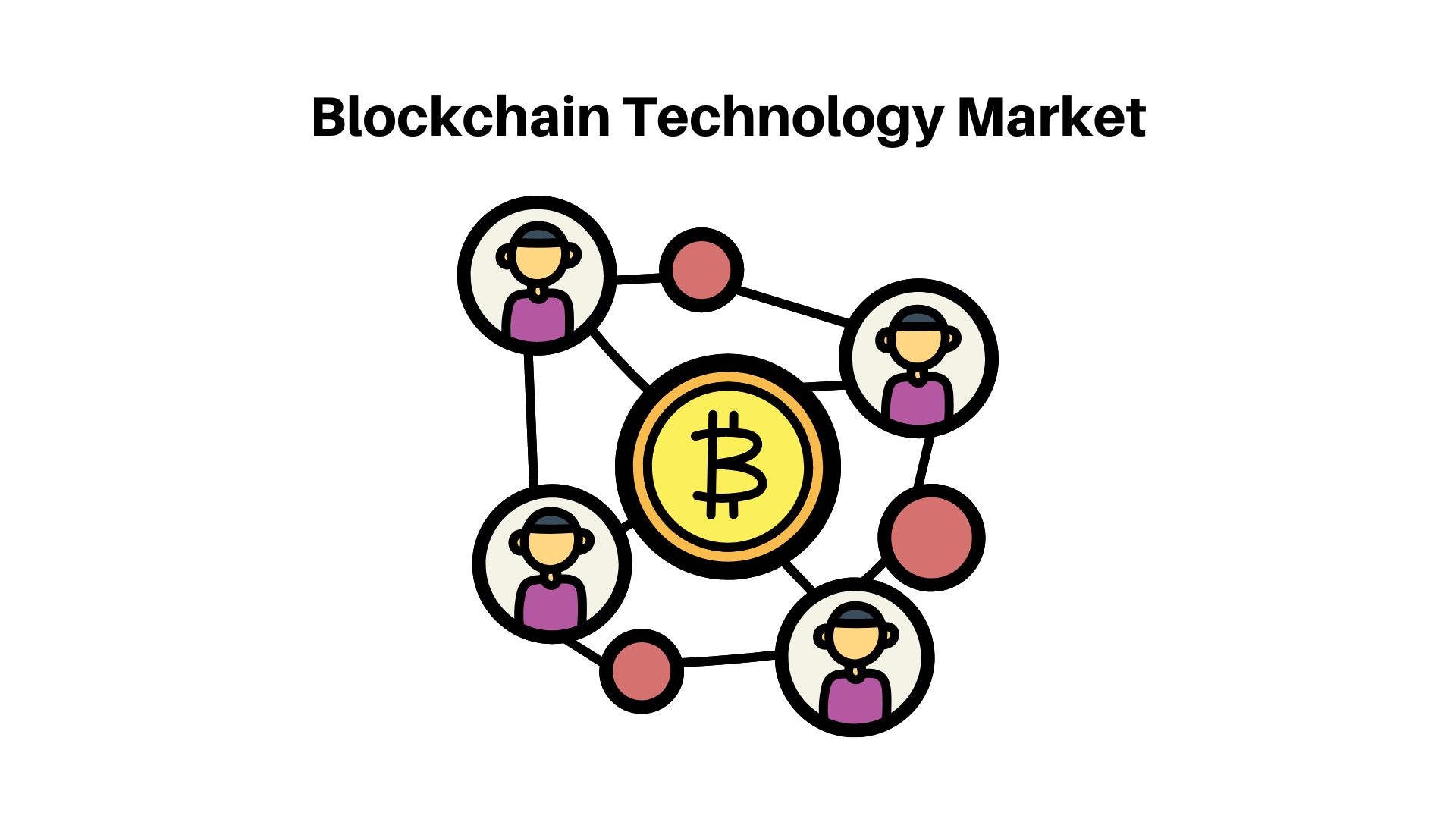High Education Software Market is Estimated to Showcase Significant Growth of USD 33.4 Bn By 2032 With a CAGR 18.7%

Page Contents
Market Overview
Published Via 11Press: The global High Education Software Market is expected to experience substantial growth over the coming years due to the COVID-19 pandemic which has intensified online learning and remote teaching, driving demand for software solutions that facilitate these modes of education.
The High Education Software Market is expected to experience a compound annual growth rate (CAGR) of 18.7% during the forecast period, rising from USD 6.0 Bn in 2022 to an impressive USD 33.4 Bn by 2032.
The report highlights the key drivers of growth in this market including the rising use of mobile devices and social media in education, an increasing desire for personalized learning experiences, as well as a need to enhance administrative efficiency and student engagement.
Product offerings from learning management systems (LMSs) are expected to lead the market, offering a comprehensive platform for managing and delivering educational content. Other software solutions with significant growth potential include student information systems (SISs), academic analytics solutions, and virtual classroom software.
Geographically, North America is expected to remain the leading market for higher education software, due to several leading players and the high adoption of technology in education. However, Asia-Pacific will experience the highest growth rate during this forecast period due to increased investments in educational infrastructure and increasing adoption of e-learning solutions.

Drivers, trends, and challenges have an impact on market dynamics, which can impact businesses. Request for PDF sample report
Key Takeaways
- The global higher education software market is forecast to experience significant growth over the coming years, driven by an increasing need for online and remote education solutions.
- Learning management systems (LMSs) are expected to dominate the market, offering a centralized hub for managing and distributing educational content.
- North America is expected to remain the leading market for higher education software, while Asia-Pacific regions are predicted to experience the highest growth rate over the forecast period.
Regional Snapshot
- North America is projected to remain the leading market for higher education software, due to the presence of several leading players and the high adoption of technology in education. The United States leads this region due to the increasing number of students opting for online learning, the demand for personalized learning experiences, and the abundance of higher education institutions.
- Europe is expected to witness steady growth in the e-learning market, spurred on by increasing adoption of e-learning solutions, demand for personalized learning experiences, and an inclination towards gamification in education.
- The Asia-Pacific region is predicted to experience the highest growth rate during this forecast period, due to investments in education infrastructure and increasing adoption of e-learning solutions. Countries such as China and India are anticipated to be major drivers of this market growth due to their large populations and rapidly developing education sectors.
- Latin America, the Middle East, and Africa are expected to witness significant growth in this market, due to increasing adoption of technology in education and an increasing need for personalized learning experiences.
Drivers
- Growing Demand for Online and Remote Education Solutions: The COVID-19 pandemic has hastened the transition towards virtual learning environments, creating a demand for software solutions that facilitate these modes of instruction.
- Growing Demand for Personalized Learning Experiences: Students are increasingly seeking tailored educational experiences that meet their individual needs and preferences. This has driven the adoption of software solutions offering customized learning paths and content.
- Enhancing Administrative Efficiency: Educational institutions are under immense pressure to enhance their administrative effectiveness and cut costs. Software solutions such as student information systems (SIS) or academic analytics applications can assist institutions in reaching these objectives.
- Utilization of Mobile Devices and Social Media in Education: Mobile devices and social media are increasingly being employed in educational settings to engage students and enhance learning outcomes. This has spurred the demand for software solutions that integrate with these platforms.
Restraints
- High Initial Investment Costs: Implementing and integrating high-education software solutions may require a substantial upfront investment, which may prove prohibitive for some educational institutions.
- Limited IT Infrastructure in Some Regions: In certain regions, the IT infrastructure may not be well developed, which may restrict the adoption of high-education software solutions.
- Data Privacy and Security Issues: Educational institutions often possess sensitive student data, making them particularly vulnerable to cyberattacks. This poses concerns about data privacy and security that could restrict the adoption of high-education software solutions.
- Lack of Awareness and Technical Skills: In certain regions, the lack of awareness and technical capabilities to use high-education software solutions may prevent their widespread adoption.
Opportunities
- Growing Demand for Lifelong Learning: With the rapid pace of technological change and the need to upskill and reskill, there is a rising need for lifelong learning. This presents an opportunity for high-education software solutions that can personalize learning experiences while encouraging continuous improvement.
- Adoption of Artificial Intelligence (AI) and Machine Learning (ML) in Education: AI and ML are increasingly being employed in education to personalize learning experiences, automate administrative tasks, and enhance student outcomes. This presents an opportunity for high-education software solutions that incorporate these technologies.
- Expansion of e-learning in emerging markets: Emerging economies such as China, India, and Brazil have large populations and rapidly developing education sectors. The expansion of e-learning in these locations presents an opportunity for high-education software solutions that can meet the demands of these markets.
- Increasing Demand for Virtual and Augmented Reality in Education: Virtual and augmented reality technologies are increasingly being utilized in educational settings to offer immersive learning experiences. This presents an opportunity for high-education software solutions that incorporate these technologies.
Challenges
- Ensuring Accessibility and Inclusivity: Online and remote education can present difficulties for students with disabilities or limited technology access. Ensuring accessibility and inclusivity is a major challenge for high-education software solutions.
- Maintaining Data Privacy and Security: Educational institutions hold sensitive data about their students, leaving them vulnerable to cyberattacks. Upholding data privacy and security is a challenge for high-education software solutions.
- Ensuring Quality and Relevant Content: Educational content must meet certain quality and relevance criteria to encourage student engagement and improve learning outcomes. Maintaining this balance is a challenge that high-education software solutions must tackle in order to succeed.
- Adapting to Shifting Market Dynamics: The high education software solutions market is rapidly transforming, with new technologies and competitors appearing. For providers of such software, adapting to these shifting dynamics poses a major challenge.
Recent developments
- In February 2022, Blackboard Inc., a leading provider of educational software solutions, announced the launch of Blackboard Learning Suite, a comprehensive platform for managing and delivering educational content.
- In November 2021, Coursera, an online learning platform, announced the acquisition of education software provider Edfinity, with the aim of expanding its reach in the high-education software market.
- In August 2021, Instructure, a provider of learning management systems, announced the launch of Canvas Educate, a platform that provides educators with resources and tools for teaching digital literacy skills.
Key Market Segments
Type
- Collaborative Learning
- Adaptive Learning
- Social Learning
- Blended Learning
Application
- State Universities
- Community Colleges
- Private Colleges
Key Market Players
- Adobe Systems Incorporated
- Blackboard
- Educomp Solutions Ltd.
- Cisco Systems
- McGraw-Hill Education
- NIIT Limited
- Pearson PLC
- Desire2learn Corporation
- Samsung Electronics
- Sum Total Systems#LLC
Report Scope
| Report Attribute | Details |
| The market size value in 2022 | USD 6.0 Bn |
| Revenue forecast by 2032 | USD 33.4 Bn |
| Growth Rate | CAGR Of 18.7% |
| Regions Covered | North America, Europe, Asia Pacific, Latin America, and Middle East & Africa, and Rest of the World |
| Historical Years | 2017-2022 |
| Base Year | 2022 |
| Estimated Year | 2023 |
| Short-Term Projection Year | 2028 |
| Long-Term Projected Year | 2032 |
Frequently Asked Questions
Q: What is high education software?
A: High education software refers to software solutions that are designed to support educational institutions in managing and delivering educational content. These solutions can include learning management systems, student information systems, academic analytics solutions, and more.
Q: What are the key drivers of the high-education software market?
A: The key drivers of the high education software market include the increasing demand for online and remote education solutions, the growing demand for personalized learning experiences, the need to improve administrative efficiency, and the use of mobile devices and social media in education.
Q: What are the key challenges facing the high-education software market?
A: The key challenges facing the high education software market include ensuring accessibility and inclusivity, maintaining data privacy and security, ensuring quality and relevance of content, and adapting to changing market dynamics.
Q: What are the opportunities in the high-education software market?
A: The opportunities in the high education software market include the growing demand for lifelong learning, the increasing adoption of artificial intelligence and machine learning, the expansion of e-learning in emerging markets, and the increasing demand for virtual and augmented reality in education.
Q: Which region is expected to see the highest growth rate in the high-education software market?
A: The Asia-Pacific region is expected to see the highest growth rate in the high-education software market, driven by the increasing investments in education infrastructure and the rising adoption of e-learning solutions.
The team behind market.us, marketresearch.biz, market.biz and more. Our purpose is to keep our customers ahead of the game with regard to the markets. They may fluctuate up or down, but we will help you to stay ahead of the curve in these market fluctuations. Our consistent growth and ability to deliver in-depth analyses and market insight has engaged genuine market players. They have faith in us to offer the data and information they require to make balanced and decisive marketing decisions.



